Beech, the Mother Tree, Queen of the Forest
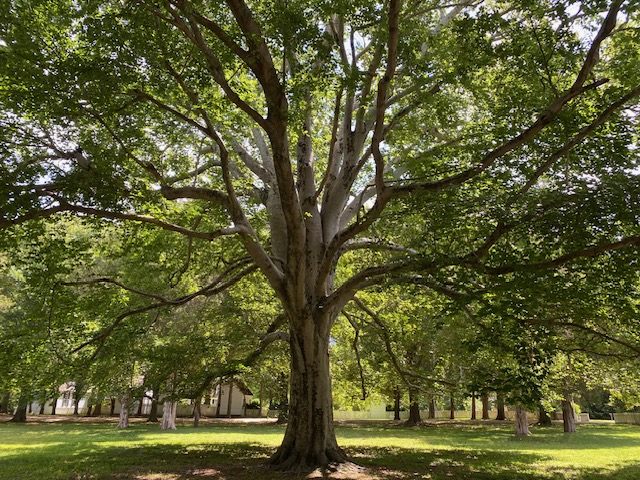
An American beech growing in front of Bassett Hall at Colonial Williamsburg is estimated to be 306 years old. Photo courtesy of Rick Brown
A Mythic Forest
The American beech, Fagus grandifolia, once covered most of North America from Canada to Mexico and from the Atlantic to the Pacific coasts. Before colonists cleared our ancient forests for farmland, large beech groves grew as part of the climax forest community. A single beech tree can live for centuries, and as it ages it surrounds itself with sapling trees growing as suckers from its relatively shallow root system, forming an expanding grove of graceful beech trees.
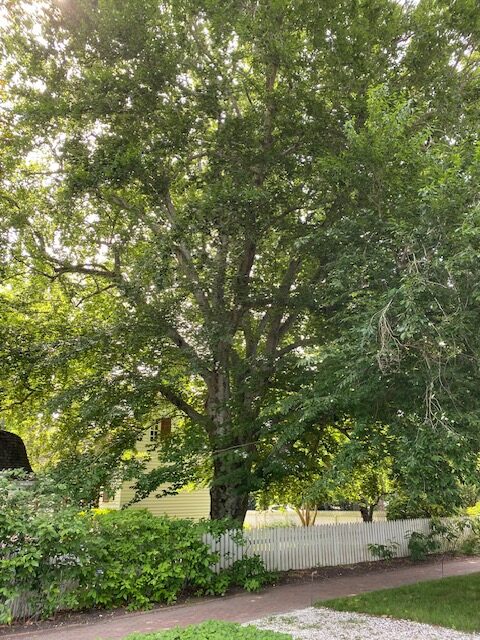
The American beech growing in the Nelson-Galt yard at Colonial Williamsburg is estimated to be 265 years old. Photo courtesy of Rick Brown.
The Mother Trees
Beech trees nurture their young through the mycorrhizal network of fungi growing symbiotically with their roots. Sugars produced in the leafy canopy of a mature mother tree will be shared far and wide with saplings and ground layer plants growing in her shade. Beech saplings grow slowly for decades in the shade of more mature trees, before finally breaking through into the sunlight and reaching their maturity around 40 years of age.
Beech trees produce young saplings as suckers growing from their roots, and they also eventually produce edible seeds. While trees between 10 and 40 years of age may produce a light crop, heavier masts aren’t produced until the tree is mature. Once a beech tree has matured enough to reliably produce an annual crop of seeds, its nuts sustain a wide variety of more than 30 animals, from deer to squirrels, including many species of birds.
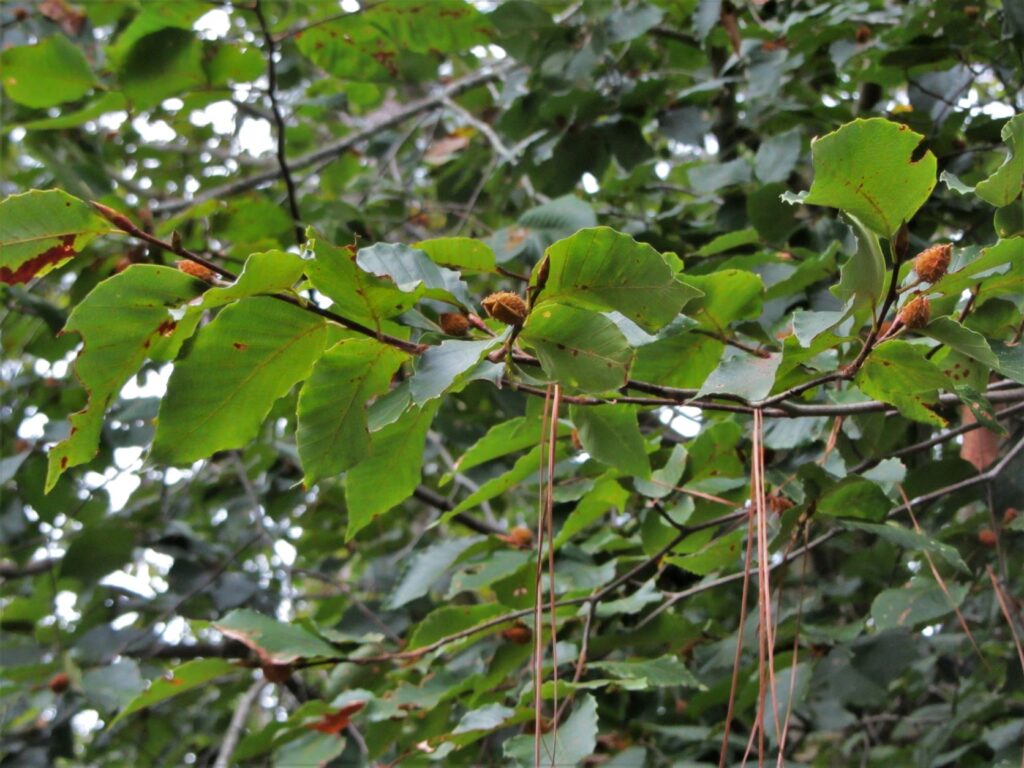
Beech nuts are nutritious and delicious. Two or three seeds grow within each spiny capsule. Collect and sow F. grandifolia, American beech seeds when they are fresh, as soon as their shells crack open.
Food for the People
Native Americans found beech nuts good to eat both raw and roasted. They contain compounds which can produce unpleasant symptoms when a large quantity of beech nuts is eaten raw, but roasting neutralizes those compounds. Beech nuts may be eaten whole or ground into flour. Native Americans pressed beech nuts to render their oils. Early colonists learned to brew a coffee-like beverage from roasted and ground beech nuts. Tender young beech leaves, high in protein, are also edible raw or boiled.
Forest Medicine
Native Americans discovered many medicinal uses for the beech tree’s leaves and bark. Both have anti-bacterial and anti-fungal properties and were used in a variety of ways for healing. Beech leaves may be boiled and used as a poultice on wounds and to bring down fevers. They are used to reduce swelling, clean the blood, and heal skin irritation. Even rainwater that has collected in the hollow of a beech tree is believed to have medicinal properties for clearing up rashes on the skin. Europeans noticed the same healing qualities in their native of beech species, and so colonists and native Americans eventually were able to share their own uses for beech bark and leaves and collaborate in their healing arts. There is a Bach flower remedy currently available made with beech.
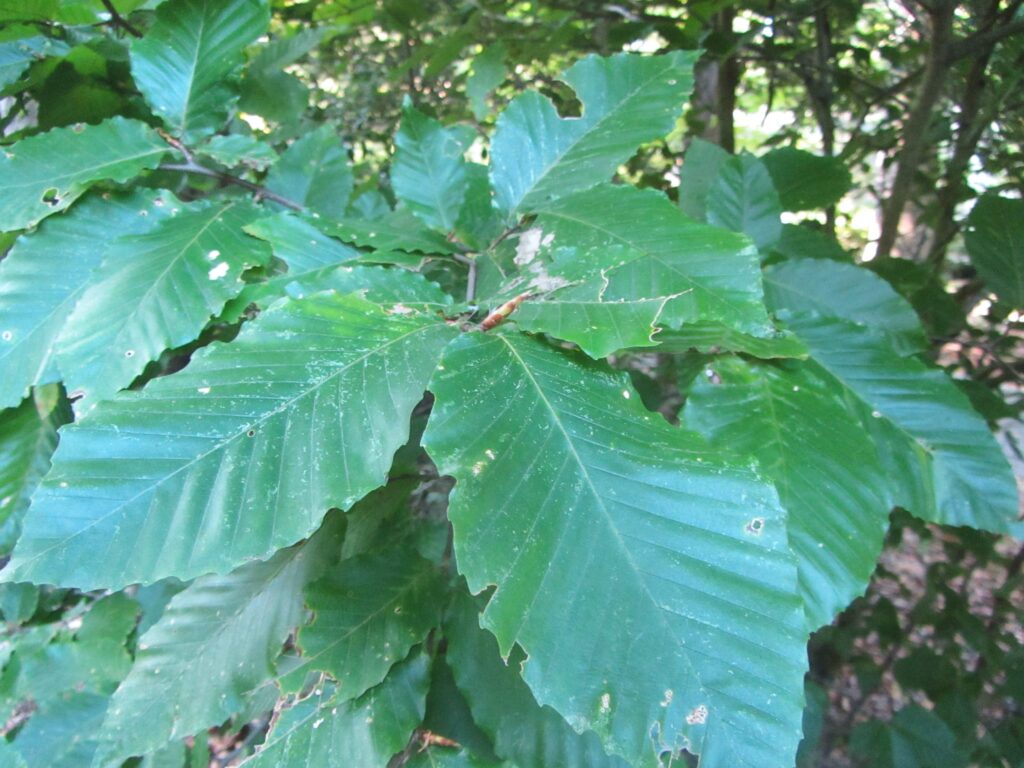
By September, beech leaves have fed many insects and have turned dark green and leathery. Their elliptical shape, prominent veins, and toothed margins resemble chestnut and chinquapin leaves.
The Climax Forest Community in Our Region
The beech tree is usually found growing amidst oaks, hickory trees, sugar maples, Magnolias, native hollies, and other climax species found in old growth forests. Climax species trees grow in the shade of faster growing pioneer species, like pine and tulip trees, which require more sunlight for their seedlings. Beech, oak, and chestnut trees are all species in the family Fagaceae. All three hardwood trees are known for their strong, useful wood, their beautiful leaves, and for their edible nuts. Chestnut trees once grew alongside beech, oak and hickory before the chestnut blight, a pathogenic fungus, killed most of our indigenous chestnut trees in the early 20th century.

Another view of the 306 year old beech growing in front of Bassett Hall at Colonial Williamsburg. Photo courtesy of Rick Brown
Beech, the Queen of the Forest
The beech tree is considered the queen of the forest, in traditional folklore, growing beside oak and holly, the forest’s seasonal kings, and is a strikingly beautiful tree in all seasons. Her thin, light green leaves cast a golden, greenish light as sunlight shines through them. Her bark is light bluish grey and smooth, even as the tree ages. Beech trees are easy to spot as their smooth trunks and limbs reflect sunlight and moonlight even where the forest is thick and dense.
As beech leaves turn coppery gold in autumn, they dry out, but cling to their twigs until spring. Long, sharp buds grow along the beech’s twigs through the winter as they prepare to open into new leaves the following spring. The pale trunks and limbs of beech trees, topped with their coppery crown of leaves, gives beech a noble appearance which shines like a beacon through the winter forest.
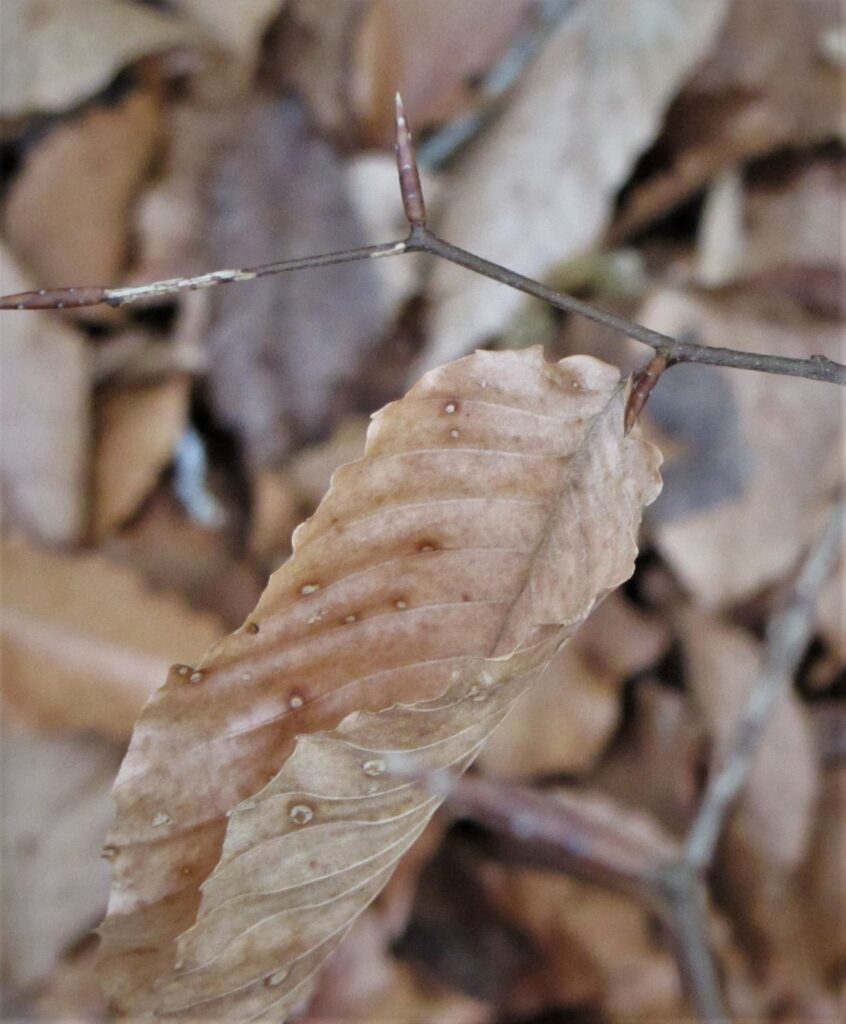
The buds of American beech are elongated and thin. Faded coppery leaves often persist through the winter.
In spring, beech trees produce both male and female flowers on each mature tree. Neither is showy, though the male catkins are more noticeable in spring than the smaller female flowers. The flowers bloom in shades of green and white from March through May and support native bees and other pollinators. Flowers may begin to emerge before the leaves unfurl in April.
Beech trees usually grow to somewhere between 80’ and 100’ high, depending on available light and moisture, but may grow to more than 100’ in favorable conditions. Their trunks grow quite stout over time and may appear twisted or textured, particularly at their base, though their bark remains smooth. Roots may be visible, poking up through the soil as the tree ages. They never grow particularly deep roots and so may be blown over in high winds if they aren’t growing in a cluster of other trees for support and protection.
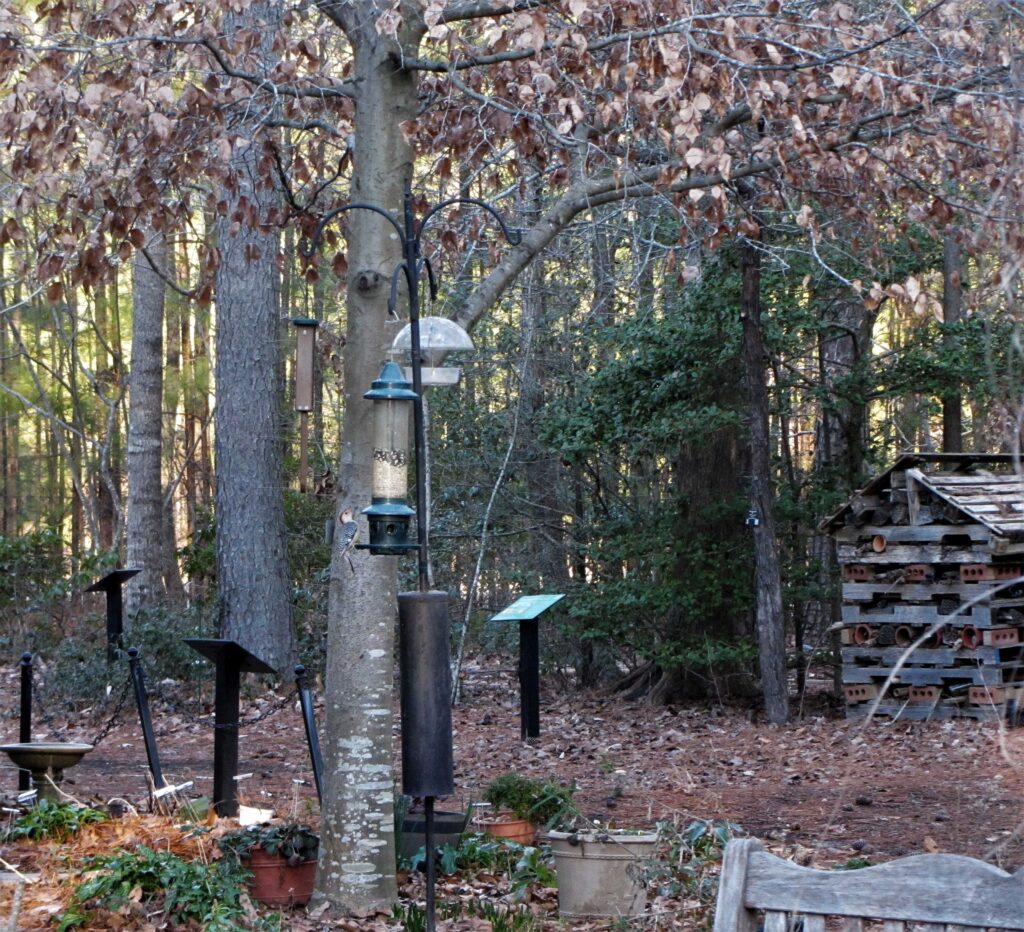
Beech trees hold onto most of their leaves through the winter, only dropping them as flowers and new leaves emerge in spring. Williamsburg Botanical Garden and Freedom Park Arboretum, January 2020.
Beech Species in the Northern Hemisphere
The American beech, unlike its European kin, Fagus sylvatica, prefers to grow where the air is clean and there is plenty of space to expand. These trees may be 80’ wide at maturity. They want moist, but not wet, neutral to acidic soil and can tolerate some salinity. Beech trees don’t grow well on compacted soil. An American beech will grow in Zones 3 to 9. Trees growing in the southern portion of the range, and particularly those growing in or near Mexico, will sometimes be designated as the sub-species, F. grandifolia subsp. mexicana. But there is generally only one recognized species of American beech.
Beech trees are known throughout the Northern Hemisphere. There are ten or more distinct species of the genus Fagus, mostly found in Europe and Asia. A subgenus grows only in East Asia and has a distinctly different growth pattern. Related trees growing in the Southern Hemisphere, in the genus Nothofagus, now are classified in a separate family. F. sylvatica, most closely related to F. grandifolia, grows in Zones 4-7b, and so is rare in our area.
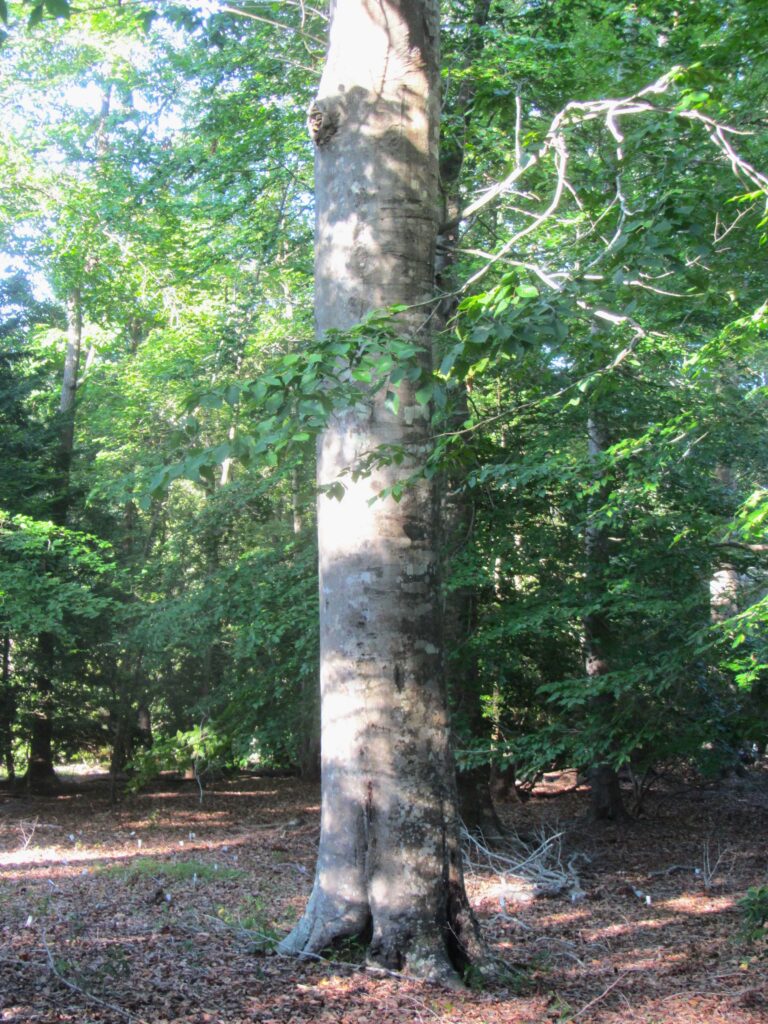
This is one of several American beech trees growing in our neighbor’s yard. The trees are all quite old and offer a heavy harvest of beechnuts each fall.
The European beech is different from our American beech in several ways. It is a smaller tree, growing only to around 60’ tall, and has a slightly smaller leaf. It can tolerate air pollution and so is commonly used as a street tree and in city parks. There are more than a dozen different recognized varieties and cultivars of F. sylvatica, allowing for a variety of growth habits, sizes, and even leaf colors. The two species share their distinctive smooth, light bark, beauty, and both have edible nuts. American colonists began importing F. sylvatica varieties beginning in around 1750 to plant in their own gardens and parks. Americans still plant ornamental European beech trees for their beauty and smaller mature size, and they remain a popular street tree in cooler regions.
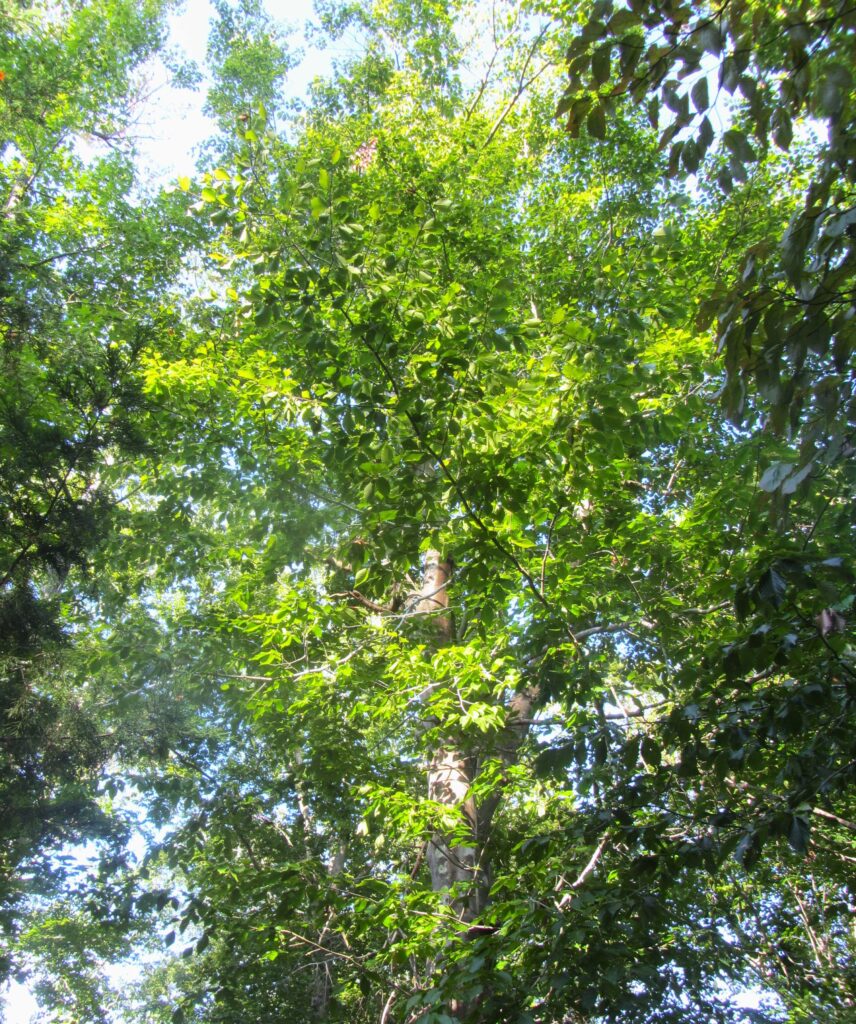
Morning sun shines through part of the canopy of our neighbor’s beech tree. Trees like this once grew in our Eastern hardwood forests, and in many places throughout North America. Its companions in our area are oaks, hickories, Virginia red cedar, and Magnolias.
Colonization Decimated Historic North American Forests
Captain John Smith and his company easily recognized the beech trees growing in Virginia when they were exploring in the early 1600s, because they looked so much like the beech trees back home in England. Oak, chestnut, and hickory trees were more plentiful than beech trees largely because they were better able to withstand occasional wildfires with their thicker, tougher bark. Wildfires continued to shape our forests until around the 1940s.
But as colonists moved westwards away from the Atlantic coast, they soon recognized that beech trees are a sign of excellent soil. Beech trees grow best in fertile soil, and their nutrient rich leaves also feed the soil as they decompose. Colonists soon cleared the beech dominated woodlands to plant their crops. Most American beech trees grow East of the Mississippi River today.

A squirrel forages among the branches of an American Beech growing in the WBG-FPA in April 2022. Most of last season’s leaves have fallen as the tree blooms and new leaves emerge from their buds.
Beech Trees Anchor the Web of Life
Although American beech trees aren’t as common as they once were, they are still valued as shade trees on larger properties and for their beauty. They are also excellent for attracting and supporting wildlife, hosting over 125 Lepidoptera species as well as other insects. Trees often form hollows as they age, offering cavities for nesting. Their canopies provide both habitat and cover for squirrels and birds, and their abundant seeds feed wildlife from around October, when the nuts begin to ripen, until early summer.

An American beech shades one of the perennial beds at the Williamsburg Botanical Garden in June of 2020.
How to Grow Your Own Beech Tree
If you want to start beech trees from seed, gather seeds in autumn, remove the two or three triangular seeds from their spiny husk, and sow them in good soil. Seeds should be sown within six months of ripening unless they are frozen for storage. If you sow the seeds where you want them to grow, then first spray them with an animal repellent like Plantskydd or Repels-All to keep animals from smelling them and digging them up. Consider covering the spot where you plant them with an upturned pot or some other physical barrier to protect them as they germinate. Alternatively, sow the fresh seeds in a container that you can leave outdoors, covered, through the winter. Transplant the seedling trees the following fall.
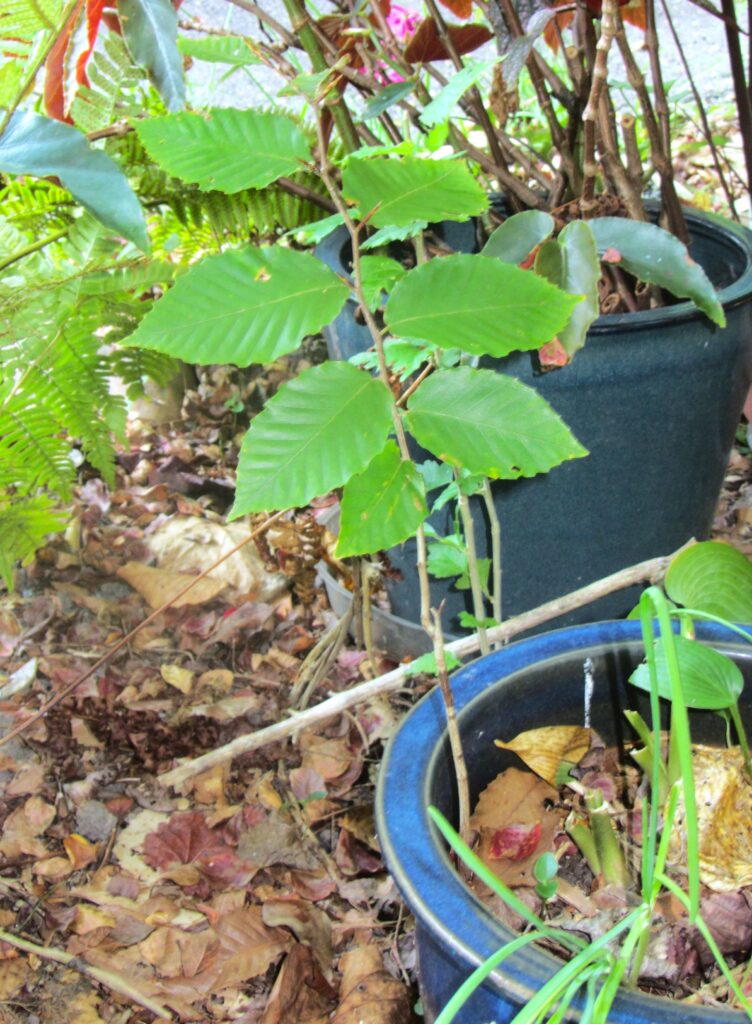
A ‘nature planted’ seedling beech tree grows from container where the Hosta was grazed by deer. This beech tree, at least two years old, is large enough to plant out into a permanent location this fall.
Beech cuttings taken in mid-summer, from mid-June through late July, may root. To grow a new beech tree from a cutting, take a 6″-8″ tip cutting from a young tree, removing its lower leaves. Strike the cutting in good moist, sterile potting soil or perlite so that at least two of its lower nodes are covered by soil. Keep the cutting under a mist or in an enclosed space to hold humidity while the cutting roots. Always keep cuttings in the shade until they form roots. The cutting should root within 8 to 10 weeks. Once roots begin to form, the cutting no longer needs mist or extra humidity. Just keep the soil moist as the cutting grows on. Pot up cuttings individually in gallon pots and overwinter the young tree in a protected spot outdoors. Wait to plant it into its permanent place the following autumn.
Beech trees will grow in the shade, but they grow faster with more sunlight. Beech saplings will grow in full or partial sun as long as they are kept watered during dry spells through their first few years. The area under a beech tree should be mulched rather than tended as lawn because the tree’s dense shade makes it hard to grow grass, and because mowing can damage the tree’s shallow roots. Most plants don’t do well growing beneath a beech, even though the beech helps to feed them through the mycorrhizae.
Fagus Myth, History, and Magic
Beech trees appear in myth and folklore as wise, protective, nurturing, generous, wish-granting forces of nature. Fagus trees are included in the Druidic Ogham Tree Alphabet as the glyph Phagos, sounding as ‘Ph” or ‘F’. Phago is a Latin prefix for eating or swallowing. Beech is also associated with the Germanic Runic alphabet, and tradition holds that runes were carved on pieces of beech wood to carry, and to pass on to others. Runes were also carved into the bark of standing beech trees for various purposes. People through the ages have carved ‘arborglyphs’ in the smooth bark of beech trees, knowing that their marks would last for the life of the tree. Couples have traditionally carved their initials in beech bark to declare their love and wish for a life-long relationship.
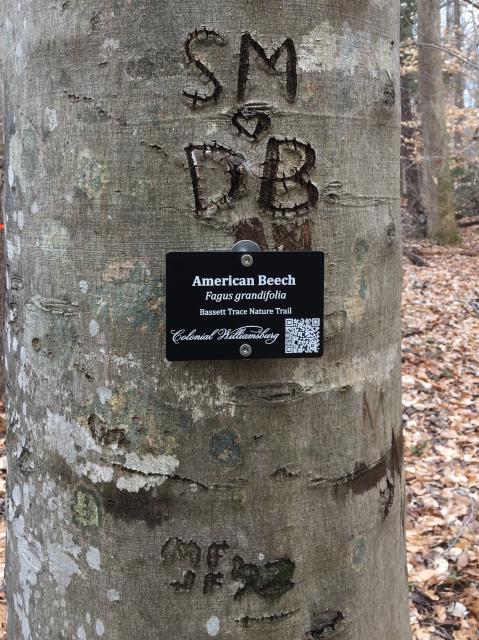
An American beech with arborglyphs on the Bassett Trace Nature Trail at Colonial Williamsburg. Photo courtesy of Rick Brown
Beech trees are strongly associated with books and writing. Before paper was common, books were written on very thin slices of beech wood, bound together, and so ‘beech’ is synonymous with ‘book’ in several European languages. In modern German, Buche is beech and buch is book. Boc is the Anglo-Saxon word from beech, which became book. In Swedish, bok is the word for both book and for beech.
The beech tree was regarded as a tree of knowledge or wisdom, as it is associated with the ability to record words and symbols and pass wisdom on from generation to generation. In Celtic culture, some carried beech seeds with them as talismans, reminding them to seek the truth and that knowledge is power. There is also a folk-practice on writing one’s wish on a stave of beech wood, and then burying the wood among the beech’s roots, allowing the wish to manifest as the wood decomposes.
Restoring the Land with Beech Trees
The American beech, like the European beech, is a nurturing, protective, mother tree, feeding thousands from its flowers, leaves, roots, and seeds. It improves the soil where it grows as it shelters all beneath it with its dense canopy. It purifies the air as it provides homes for small animals. Beech trees provide all these ecological services while remaining regal and beautiful in all seasons. The American beech is a magnificent native tree, as important in our modern landscapes as it was in centuries passed. Trees planted today will ensure a better, more vibrant world for those who enjoy them in years to come.
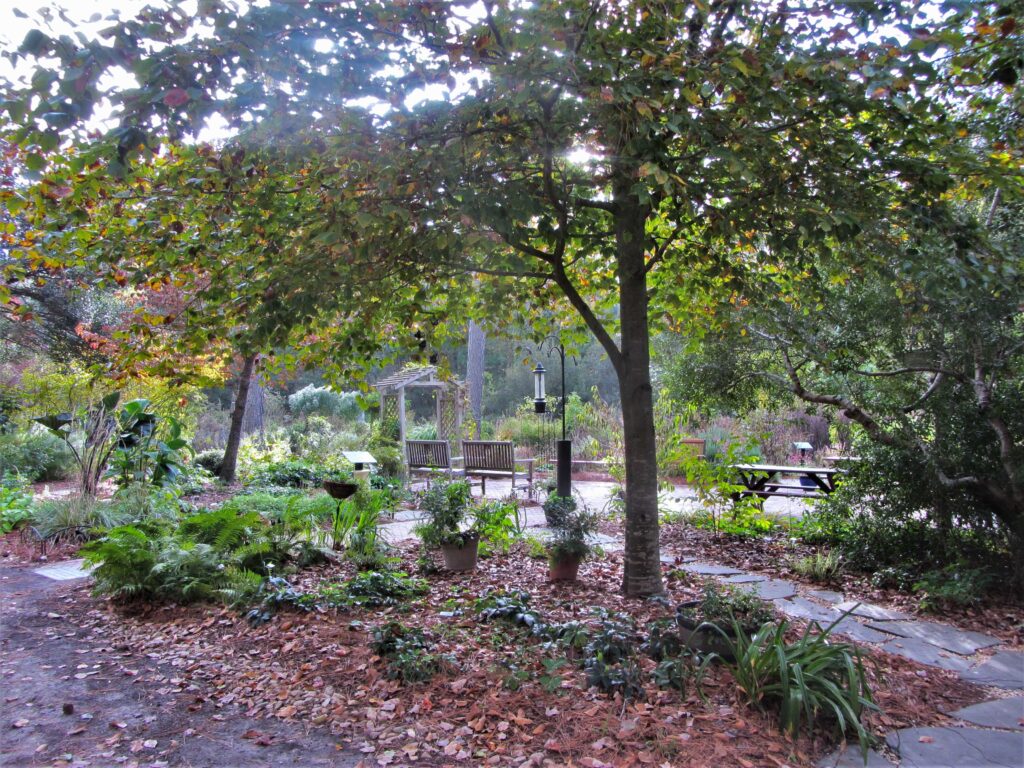
This beech will hold onto its leaves as they fade and turn coppery brown over winter. November 2021, at the Williamsburg Botanical Garden and Freedom Park Arboretum.
All photos by Elizabeth McCoy or Rick Brown, Master Gardener Tree Stewards
To Learn More
Dirr, Michael A. Dirr’s Encyclopedia of Trees and Shrubs. 2016.
Lambe, Dan. Now Is the Time for Trees: Make an Impact by Planting the Earth’s Most Valuable Resource. 2022.
Lewis, Hannah and Paul Hawken. The Mini-Forest Revolution: Using the Miyawaki Method to Rapidly Rewild the World. Chelsea Green Publishing. 2022.
Pearce, Fred. A Trillion Trees: Restoring Our Forests by Trusting in Nature. Greystone Books. 2022.
Phillips, Michael. Mycorrhizal Planet: How Symbiotic Fungi Work with Roots to Support Plant Health and Build Soil Fertility. Chelsea Green Publishing. 2017.
Silver, Akiva and Samuel Thayer. Trees of Power, Ten Essential Arboreal Allies. Chelsea Green Publishing. 2019.
Stamets, Paul. Mycelium Running: How Mushrooms Can Help Save the World. Ten Speed Press. 2005
Stewart, Amy. The Tree Collectors: Tales of Arboreal Obsession. Random House. 2024.
Shrubsole, Gary. The Lost Rainforests of Britain. William Collins. 2022.
Tallamy, Douglas. Bringing Nature Home: How Native Plants Sustain Wildlife in Our Gardens. 2007.
Tree, Isabella. Wilding: Returning Nature to Our Farm. New York Review Books. 2019.
Tree, Isabella. The Book of Wilding: A Practical Guide to Rewilding Big and Small. Bloomsbury Publishing. 2023.
More From This Website:
Holly, King of the Winter Forest
